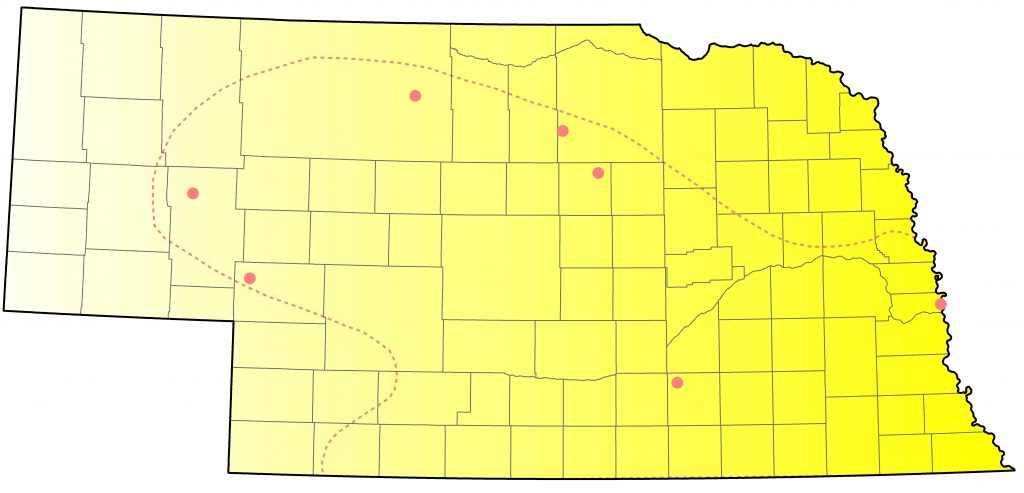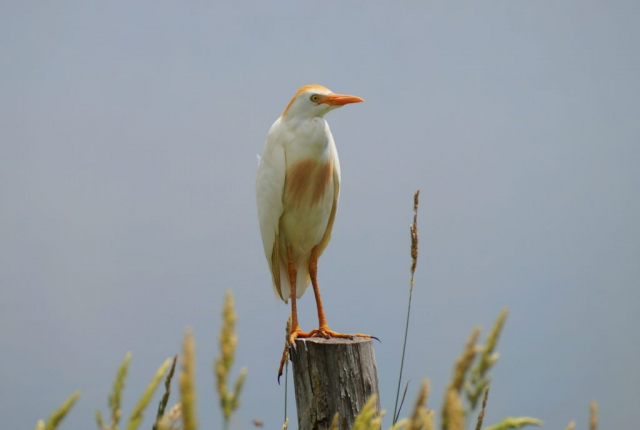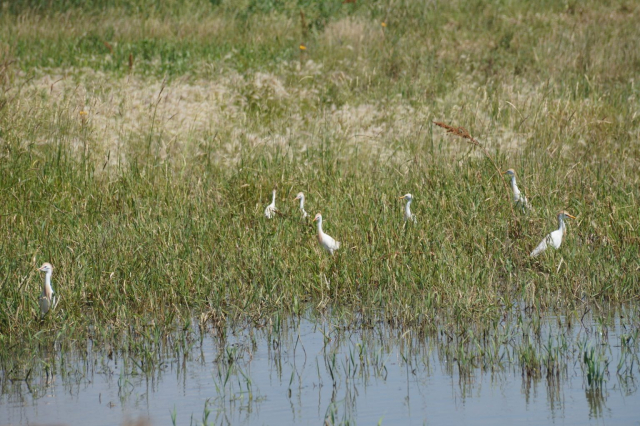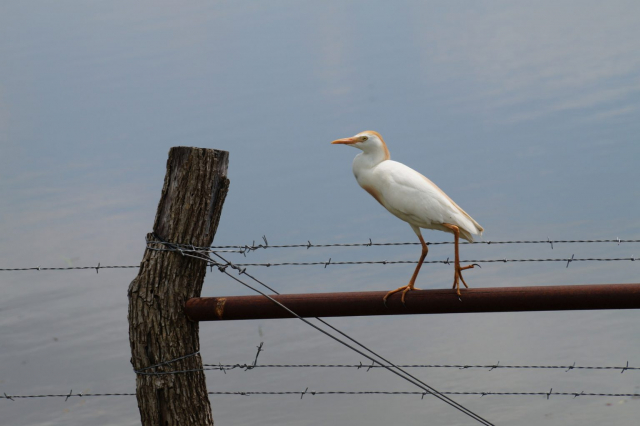ARDEA ibis
Status: Uncommon, locally common, regular spring and fall migrant east and central, uncommon west. Uncommon, locally common, regular summer visitor east and central, rare west. Fairly common casual breeder statewide. Documentation: Photograph: 7 May 1983 Albion, Boone Co (Molhoff 1989).
Documentation: Photograph: 7 May 1983 Albion, Boone Co (Molhoff 1989).
Taxonomy: Former genus Bubulcus was merged into Ardea based on genetic data (Hruska 2023).
Traditionally three subspecies within Bubulcus had been recognized (Telfair 2020), coromandus of southern and eastern Asia and Australasia, ibis of Africa, Europe western Asia, and North America, and putative seychellarum of the Seychelles Islands. Chesser et al (2024) raised subspecies ibis to specific status, in which case North American birds become monotypic Ardea ibis, Western Cattle-Egret.
No subspecies are recognized within Western Cattle-Egret Ardea ibis (AviList 2025).
Spring: Apr 1, 2, 3 <<<>>> summer
Earlier dates are 26 Mar 2007 Otoe Co, 27 Mar 2021 Johnson Co, and 30 Mar 2014 Lancaster Co.
Most arrive beginning in mid-Apr.
- High counts: 140 at Nebraska City, Otoe Co 30 May 1996, 60 at Harvard WPA, Clay Co 30 Apr 2005, 50 near Lincoln, Lancaster Co 10 May 1996, and 50 in Wheeler Co 20 May 1996.
Summer: This species is an immigrant to the New World from Africa, arriving in South America in the late 19th Century. It was first seen in North America in 1941 and has expanded its range north and west since that time (Palmer 1962, Telfair 2020). It was first observed in Nebraska 11 Sep 1965 in Adams Co (Welch 1966), and occurrence became regular in the early 1970s. The first Panhandle record was 26 May 1979 in Garden Co.
There are several reports of breeding. The first report was by Len McDaniel of a nesting pair at Valentine NWR, Cherry Co in 1982 (Mollhoff 2022). Five nests were found by Don Emrick among those of cormorants and night-herons on Middle Marsh Lake, Valentine NWR 22 Jun 1984 (Ducey 1984; Mollhoff 2001, 2022), followed by the discovery in the same colony by Len McDaniel of 22 pairs with 50 nestlings 21 Aug (Mollhoff 2022). A colony of at least seven active nests was established in a clump of willows on a small island at Offutt Base Lake, Sarpy Co in 1993 (Roger Sharpe, personal communication). In extreme northeast Garfield Co in 1994 at least 50 nests, all of which had young by 9 Jul, were monitored by Loren Blake (reported by card to NGPC Heritage Program; Silcock and Rosche 1994). Also in 1994, 31+ birds with three nests and two under construction were in willows at the west end of Lake McConaughy, Keith Co 6-7 Aug 1994 (Dinsmore and Silcock 1995). A third 1994 record was of 115 adults carrying nest material into tall vegetation in the center of Lamb’s Lake, Holt Co (NGPC files). A nest with three small young was found at Smith Lake, Crescent Lake NWR, Garden Co 19 Jun 2007 (Mollhoff 2008), a nest with eggs was found there 21 Jun 2008 (Wayne Mollhoff, personal communication) and 30 nests were counted there 25 Jun 2009 (Mollhoff 2022). In 2019, 6-22 Cattle Egrets were observed in the Rainwater Basin, including good numbers in dense cattails at Harvard WPA, Clay Co on 24 Jul, followed by observation there of some 80 birds including multiple nests with eggs and some 2–3-week-old young on 20 Aug (Jorgensen and Brenner 2019). This is the first breeding record for the Rainwater Basin.
Reports are fewest in Jun and early Jul, but occasionally good numbers are found, such as the 85 in the eastern Rainwater Basin 12 Jun 2008. Reports Jun-Aug are likely a mix of post-breeding dispersers and birds from failed breeding colonies; exceptionally high numbers in Jun-Jul are more likely to result from the latter. Nesting colony sites are prone to flooding, and so the impressive total of 630 reported Jun-Jul 2011 probably included dispersal from failed colonies as well as post-breeding dispersers; the total included 221 in northern Cherry Co 22 Jul, and 100 near North Platte, Lincoln 25 Jun-3 Jul. Lower numbers are likely post-breeding dispersers, such as the 25 in southeast Sarpy Co Jun-Jul 2008, increasing to 36 by 23 Jul, and an Alma, Harlan Co roost in 2001 where numbers increased steadily from 6 on 10 Jun to 230 on 14 Jul.
Fall: summer <<<>>> Oct 23, 23, 24
Later dates are 26 Oct 2016 Douglas Co, 28 Oct 2024 Lake Ogallala, Keith Co, 30 Oct 2024 Niobrara, Knox Co, 1 Nov 2005 Keith Co, 1 Nov 2024 Yellowthroat WMA, Brown Co, 4 Nov 2006 Knox Co, 5 Nov 2019 Hall Co, and 12-17 Nov 2021 Lincoln, Lancaster Co. There are undocumented reports of four in Sarpy Co 15 Nov 2010, and one in Scotts Bluff Co 15-18 Nov 2004.
Reports are most numerous in early Aug, gradually declining through Sep and Oct.
- High counts: 591 in the eastern Rainwater Basin 7 Aug 2004 (588 of these at Clay Co Wetland #132), 500 in Otoe Co 5 Aug 1996, and 450 at East Odessa WMA, Buffalo Co Aug 1994.
Images
Abbreviations
NGPC: Nebraska Game and Parks Commission
NWR: National Wildlife Refuge
WMA: Wildlife Management Area (State)
WPA: Waterfowl Production Area (Federal)
Literature Cited
AviList Core Team, 2025. AviList: The Global Avian Checklist, v2025. https://doi.org/10.2173/avilist.v2025.
Chesser, R.T., S.M. Billerman, K.J. Burns, C. Cicero, J.L. Dunn, B.E. Hernandez-Banos, R.A. Jimenez, O. Johnson, A.W. Kratter, N.A. Mason, P.C. Rasmussen, and J. V. Remsen, Jr. 2024. Sixty-fifth Supplement to the American Ornithologists’ Union Check-list of North American Birds. Ornithology 141. https://doi.org/10.1093/ornithology/ukae019.
Dinsmore, S.J., and W.R. Silcock. 1995. Cattle Egrets nesting in Keith County. NBR 63: 89-90.
Ducey, J.E. 1984. Cattle Egrets and White-faced Ibises nesting at Valentine Refuge. NBR 52: 76.
Hruska, J.P., J. Holmes, C. Oliveros, S. Shakya, P. Lavretsky, K.G. McCracken, F.H. Sheldon, and R.G. Moyle. 2023. Ultraconserved elements resolve the phylogeny and corroborate patterns of molecular rate variation in herons (Aves: Ardeidae). Ornithology 140: ukad005 doi.org/10.1093/ornithology/ukad005.
Jorgensen, J.G., and S.J. Brenner. 2019. Notable avian nesting records from the Rainwater Basin, Nebraska — 2019. Nongame Bird Program of the Nebraska Game and Parks Commission, Lincoln, Nebraska, USA.
Mollhoff, W.J. 1989. Second report of the NOU Records Committee. NBR 57: 42-47.
Mollhoff, W.J. 2001. The Nebraska Breeding Bird Atlas 1984-1989. Nebraska Ornithologists’ Union Occasional Papers No. 7. Nebraska Game and Parks Commission, Lincoln, Nebraska, USA.
Mollhoff, W.J. 2008. The 2007 Nebraska nest report. NBR 76: 155-165.
Mollhoff, W.J. 2022. Nest records of Nebraska birds. Nebraska Ornithologists’ Union Occasional Paper Number 9.
Palmer, R.S., ed. 1962. Handbook of North American birds. Vol. 1. Loons Through Flamingos. Yale University Press, New Haven, Connecticut, USA.
Silcock, W.R., and R.C. Rosche. 1994. Summer Field Report, June-July 1994, NBR 62: 102-116.
Telfair II, R.C. 2020. Cattle Egret (Bubulcus ibis), version 1.0. In Birds of the World (S. M. Billerman, Editor). Cornell Lab of Ornithology, Ithaca, NY, USA. https://doi.org/10.2173/bow.categr.01.
Welch, B. 1966. Cattle Egret. NBR 34: 76.
Recommended Citation
Silcock, W.R., and J.G. Jorgensen. 2025. Western Cattle Egret (Bubulcus ibis). In Birds of Nebraska — Online. www.BirdsofNebraska.org
Birds of Nebraska – Online
Updated 23 Aug 2025



